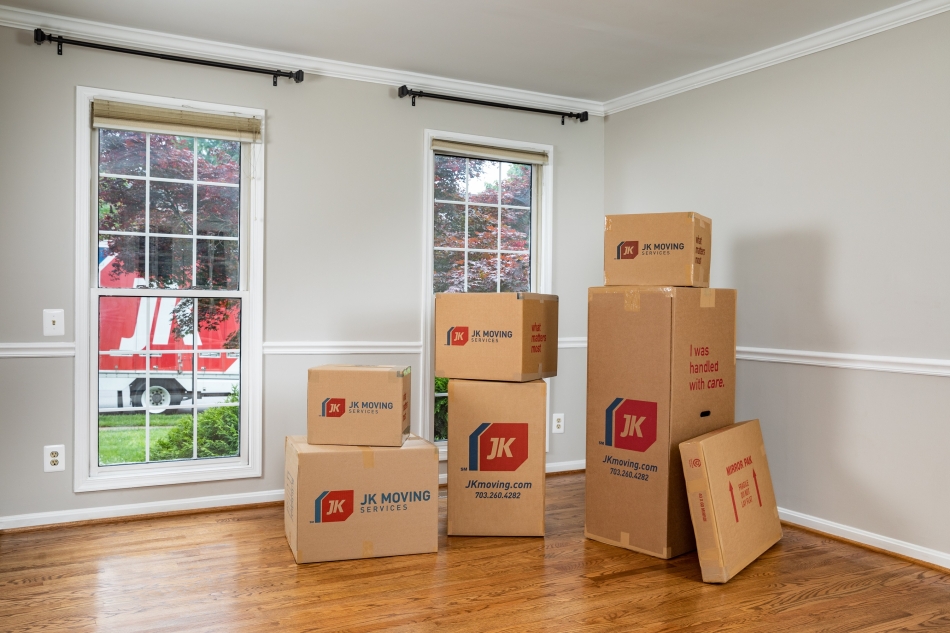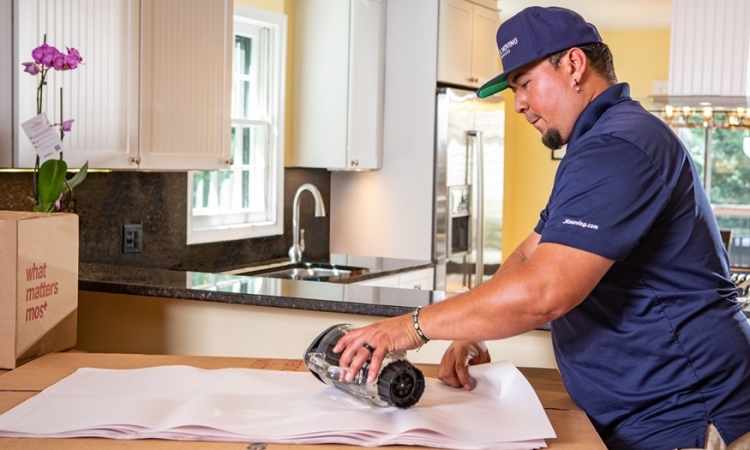Packing a kitchen is one of the trickiest parts of moving, with its mix of fragile glassware, heavy cookware, appliances, and pantry items. It can feel overwhelming to organize everything safely and efficiently.
This guide simplifies the process with practical tips, a checklist, and proven methods to keep your kitchen move manageable. With the right planning and packing materials, you can save time, reduce stress, and ensure everything arrives ready to unpack.
What is the best way to pack a kitchen when moving?
Packing a kitchen requires a strategic approach to handle its variety of items effectively. The best way to tackle this is to begin with organization and preparation.
Steps to organize before packing:
- Separate essential kitchen items from non-essentials: Identify what you’ll need immediately (e.g., coffee maker, basic utensils) and what can be packed ahead of time (e.g., holiday bakeware or specialty gadgets).
- Group items by type: Organize by category – small kitchen appliances, plates, glasses, utensils, etc. – to streamline packing and simplify unpacking.
- Clean and dry all items before packing: Ensure dishes, appliances, and containers are spotless and completely dry to prevent mold, odors, or damage.
As you pack, label each box clearly with its contents and handling instructions. Mark boxes with words like “Fragile” for glassware or “Pots and Pans” for heavier items. Clear labeling helps movers handle your belongings carefully and ensures easier unpacking in your new kitchen.
Tip: Start by decluttering your kitchen, discarding expired or unused items to reduce the amount of packing you need to do. Only bring what you truly need to your new home.
How many boxes do I need to pack a kitchen?
 The number of boxes you’ll need depends on your kitchen’s size and contents. A small kitchen needs fewer boxes than a family-sized one full of cookware, appliances, and pantry items, but having extra boxes on hand ensures you’re prepared for surprises.
The number of boxes you’ll need depends on your kitchen’s size and contents. A small kitchen needs fewer boxes than a family-sized one full of cookware, appliances, and pantry items, but having extra boxes on hand ensures you’re prepared for surprises.
Approximation guide
- Small kitchens: 15–20 medium boxes.
- Family-sized kitchens: 30+ medium boxes and specialized boxes for fragile items.
Tip: Use sturdy medium boxes for heavy items like pots and canned goods to avoid overloading.
How do you pack pots and pans for moving?
Packing pots and pans requires careful handling to avoid damage during the move. Here’s the best approach:
- Wrap each pot and pan with packing paper or bubble wrap for protection.
- Nest smaller pots inside larger ones, adding paper between layers to prevent scratches.
- Pack lids separately in small boxes, using padding to keep them secure.
Tip: Place heavier items at the bottom of the box to maintain stability and prevent shifting. Secure handles with tape or wrap them in padding to avoid movement during transit.
How to pack kitchen plates for moving?
Packing plates correctly can prevent chips and breakage during your move. Follow these steps:
- Use dish-specific boxes or medium boxes with ample padding.
- Wrap each plate individually with packing paper or foam sheets for protection.
- Place plates vertically in the box, reducing the risk of damage.
Tip: Tuck towels or linens around the plates to add extra cushioning. Pack glasses and stemware separately, using dividers for added protection.
Creating a kitchen packing checklist
Having a checklist helps you get started on how to pack a kitchen for moving. Use the checklist below to stay organized:
Kitchen packing list
Packing Materials:
☐ Sturdy medium boxes
☐ Packing tape
☐ Bubble wrap or foam sheets
☐ Packing paper
☐ Box dividers for glasses and stemware
☐ Permanent markers for labeling
Items for the essentials box:
☐ Coffee maker and supplies
☐ Basic cooking utensils (knife, spatula, spoon)
☐ Cutting board
☐ Dish soap and sponge
☐ Paper towels or cloths
☐ Plates, cups, and cutlery for the first meal
Kitchen items to pack:
☐ Small kitchen appliances (toaster, blender, etc.)
☐ Pots and pans
☐ Plates, bowls, and glassware
☐ Utensils (spatulas, tongs, ladles)
☐ Baking trays and mixing bowls
☐ Pantry goods (unopened and non-perishable items)
☐ Food storage containers
☐ Towels and linens
☐ Cleaning supplies (sponges, brushes, cleaning cloths – no chemicals)
Packing tips to follow:
☐ Label boxes clearly by category (e.g., “Pots and Pans,” “Plates – Fragile”).
☐ Pack heavy items, like canned goods, in smaller boxes to avoid overloading.
☐ Use towels or linens as padding for fragile items.
☐ Separate sharp items like knives and wrap them securely for safety.
Tip: Create a plan for unpacking at your new home by prioritizing the essentials box and arranging items based on how often you use them.
Packing small kitchen appliances and food storage containers
Packing small kitchen appliances
- Remove detachable parts and wrap them individually for added protection.
- Use original boxes when possible; otherwise, pack appliances in medium boxes with sufficient padding.
Organizing food storage containers
- Nest containers together and pack lids separately in the same labeled box.
- Ensure all containers are airtight to avoid spills during the move.
Where to put things in the kitchen at your new home
Efficient unpacking can make settling into your new kitchen much easier.
- Unpack the essentials box first to get a functional kitchen set up quickly.
- Place items logically based on how often you use them – keep daily-use plates and utensils within easy reach.
- Arrange food storage containers and appliances to maximize counter and cabinet space.
Additional kitchen packing tips for a smooth move
Here are some tips on the best way to pack kitchen items to keep them secure and accessible.
- Don’t overpack boxes, as this can lead to damage or make them too heavy to lift.
- Label all boxes clearly to save time when unpacking.
Tip: Before leaving, double-check that all kitchen items are packed and nothing is left behind.
Conclusion
Packing a kitchen can feel overwhelming, but it’s manageable with the right planning, organization, and materials. Follow these tips and the checklist for a smoother move, saving time and reducing stress. Consider the benefits of professional kitchen packing services for added convenience and peace of mind for a seamless kitchen move.


